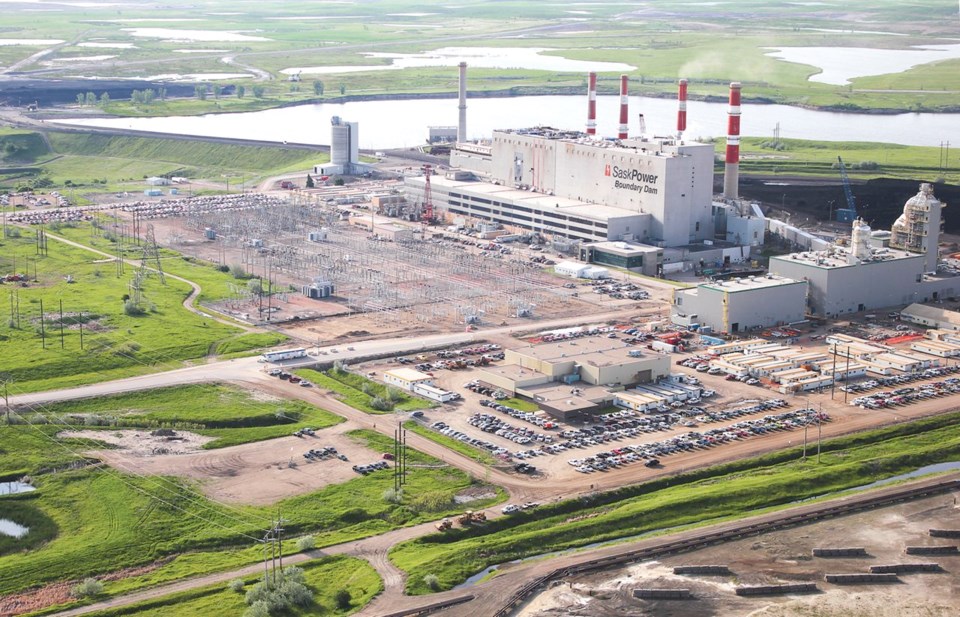SaskPower has released the year-end numbers for the carbon capture and storage facility at the Boundary Dam Power Station.
In 2018, the CCS facility captured a total of 625,996 tonnes of carbon dioxide (CO2), while the overall availability of the facility was 69 per cent. However, the availability rate increases to 94 per cent if one excludes the days when the CCS facility was available but Boundary Dam Power Station Unit 3 (BD3) was offline due to a powerful thunderstorm that struck the Estevan area on June 14.
That storm resulted in an 84-day outage at BD3. The CCS facility was unable to capture any CO2 during this period.
“We had to do quite a bit of repair to that Boundary Dam 3 turbine, and so the power plant was off for quite a time. The CCS was available, but couldn’t run because the power plant wasn’t running,” said Howard Matthews, the vice-president of power production at SaskPower.
Additionally, BD3 was down 285 hours for two separate boiler tube leaks, and 87 hours following the massive power outage that struck the province Dec. 4.
During the periods CCS was capturing CO2, the average capture rate was 2,505 tonnes per day (TPD), which is greater than the 2,435 TPD rate established as a target.
Boundary Dam became the first power station in the world in 2014 to successfully use CCS technology. Since start-up, the facility has captured 2,465,333 tonnes of CO2, the equivalent of taking 616,333 cars off Saskatchewan roads.
“It’s always important for people to remember that this is the world’s first,” said Matthews. “There have certainly been its challenges, and they’re not all fully unexpected.”
Matthews believes the facility has shown the technology works. There have been problems with the degradation of the amine chemical around some of the equipment, but SaskPower has worked hard to deal with some of those issues, with a goal to improve the reliability of the facility.
“That’s what we’re seeing here this last year, is really good, positive reliability out of that facility,” said Matthews.
The focus for SaskPower is shifting to the economics of the CCS facility, by getting costs as low as possible, so that the Crown corporation can present the best information possible to decision makers when they determine the future use of CCS across the rest of SaskPower’s coal-generating fleet.
In a press release, SaskPower noted the facility had its second-lowest operating cost per tonne of CO2 captured, but SaskPower didn’t release those numbers, or the figures for previous years.
SaskPower will also continue to work on some of the basic chemistry issues at the plant to help bring the costs of the plant down.
A shutdown is planned for later this year that Matthews said is quite a large undertaking. The focus will be a compressor in the CCS facility, which he described as being one of the largest in North America.
“There’s a rather huge motor driving it. It’s quite an assembly, this compressor, and it just goes on the amount of hours and the amount of tonnes that it has produced. You have some very, very large high-speed shafts in that compressor that are operating under tremendous horsepower and tremendous pressure.”
The compressor will come offline for about two months in March and April.
Matthews stressed this shutdown is not due to a breakdown.
While the CCS facility is offline, SaskPower will do other work on the site. A regular shutdown for BD3 will also happen at that time for boiler work.
“That’s one of the unique options that we have with this facility is we’ll bring BD3 and CCS offline at the same time,” said Matthews. The work on BD3 will finish before (shutdown to) CCS is done.”
Matthews stressed there should be a lot of people coming to the city to work on the project.
There will also be more work happening at the carbon capture test facility at the Shand Power Station, which now sits vacant. SaskPower is going to use it for its studies on the degradation issue until a new tenant is found.
“That’s where we will be looking into some options around improvements to the degradation issue in the amine. The CCS facility gives us a great opportunity to do that testing not in a lab environment, but in a scaled up system … that takes real flue gas,” said Matthews.
Shell Cansolv, which had been the tenant, has wrapped up its work in the facility. Matthews pointed out the CCS Knowledge Centre in Regina has been promoting the test facility to potential tenants.
“We do have a number of people that are interested in it. There are a number of different solutions out there, people who want to test their solutions. Those sorts of things do require quite a bit of engineering to see if it’s viable in the facility, and then it’s up to those other companies … who have to make that decision,” said Matthews.




